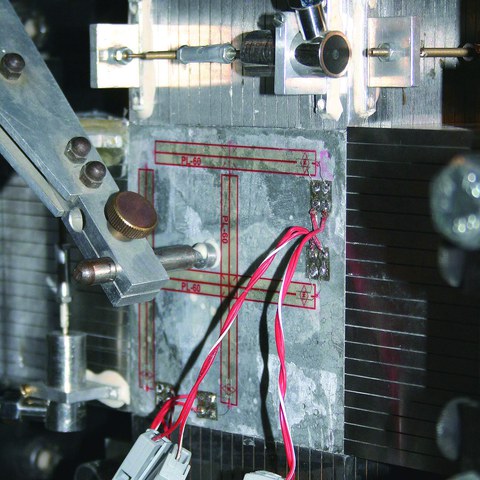Uniaxial and biaxial failure behaviour of HPC
Table of contents
Project data
| Titel | Title Ein- und zweiaxiale Festigkeit von Hochleistungsbeton | Uniaxial and biaxial failure behaviour of HPC Auftraggeber | Client Institut für Massivbau, Leibniz Universität Hannover Zeitraum | Period 10.2009 – 12.2009 Leiter | Project Manager Dr.-Ing. Kerstin Speck Bearbeiter | Contributors Dr.-Ing. Kerstin Speck, Dipl.-Ing. Kathrin Dietz, Rainer Belger, Jens Hohensee Projektpartner | Project Partners Institut für Massivbau | Leibniz Universität Hannover |
Report in the yearbook 2009
Uniaxial and biaxial failure behaviour of HPC

Bi-axial test set-up
Researchers at the Leibniz Universität Hannover required data to describe the mechanical behaviour of high performance concrete under biaxial compressive stresses.
Test Set-up
A servo-controlled, one-piece triaxial machine, consisting of one hydraulic jack in each of three directions, was used for all tests. This testing machine allows for the application of compressive and tensile loads of up to 5,000 kN and 500 kN, respectively. Each axis can be independently controlled. Loads were observed by load cells located in each axis. Steel brushes were used to eliminate restraints at the load surface. The steel brushes consist of 20 × 20 single brush rods with a gap of 0.2 mm between rods. Each rod has a 5 × 5 mm cross-section and a free length of 70 mm.
Deformation was measured by strain gauges located on the unloaded specimen surface, as well as by displacement transducers located on the steel brushes.
Loading in the primary axis was controlled by the LVDT of the testing machine, while loads in the remaining secondary direction was controlled by force measurement to insure a propor-tional stress ratio in both directions. Concrete specimens were 28 days old at the time of multiaxial testing.
Results
Failure was very brittle, without any premature indication of rupture, during uniaxial and biaxial testing. Deformations increased nearly linearly up to 95 % of the ultimate load at which point spalling of small pieces of concrete from the unloaded specimen surface began to occur. The specimen failed suddenly once the maximum load was reached.
Typical crack patterns of the samples are shown in the picture. During uniaxial testing the sample specimens broke into several columnar or discoidal pieces. The fracture surfaces were orientated nearly parallel to the primary load direction. The biaxial loaded specimens also broke into slice-like pieces. The biaxial strength was about 6 % higher than the uniaxial strength.
